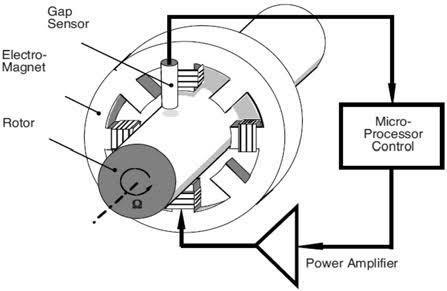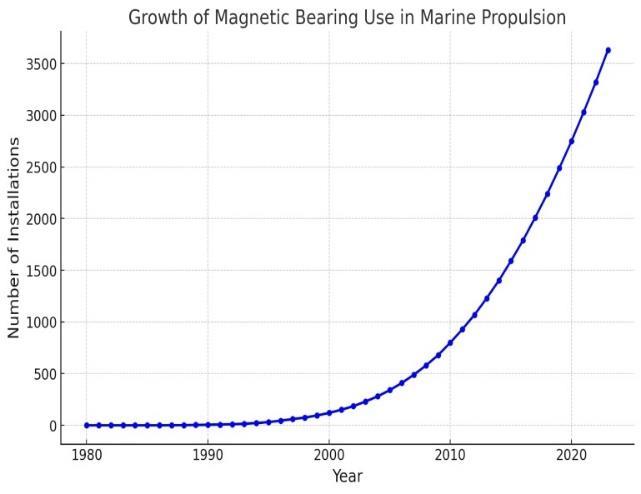
International Research Journal of Engineering and Technology (IRJET) e-ISSN:2395-0056
Volume: 11 Issue: 09 | Sep 2024 www.irjet.net p-ISSN:2395-0072


International Research Journal of Engineering and Technology (IRJET) e-ISSN:2395-0056
Volume: 11 Issue: 09 | Sep 2024 www.irjet.net p-ISSN:2395-0072
A Aswanth1 , T Ashok Dharma2, A C Mariappan3, G Peter Packiyaraj4
1,2Final Year B.E Marine Cadets, PSN CET, Tirunelveli, Tamil Nadu
3,4Assistant Professor, Department Of Marine Engineering, PSN CET, Tirunelveli, Tamil Nadu***
ABSTRACT -This paper explores the application of magnetic bearings in the propulsion systems of marine engines. Magnetic bearings offer several advantages over traditional mechanical bearings, such as reduced friction, lower maintenance requirements, and the elimination of lubrication systems. The study examines the performance characteristics of magnetic bearings in high-stress environments, including their ability to withstand the dynamic loads encountered in marine propulsion. Additionally, the impact of magnetic bearing integration on engine efficiency, noise reduction, and overall system reliability is discussed. The findings suggest that magnetic bearings could significantly enhance the performance and longevity of marine propulsion systems, making them a promising alternative to conventional bearing technologies.
The utilization of magnetic bearings in the main propulsion engines of ships presents a significant advancement in maritime engineering. This research investigates the design, implementation, and operational efficiency of active magnetic bearings (AMBs) within large-scale marine engines. The study focuses on the technical challenges associated with the integration of AMBs, including thermal management, control system precision, and load capacity. Experimental results from prototypes and real-world applications are presented, demonstrating the potential for improved fuel efficiency, reducedwearandtear,andextendedserviceintervals.The paper concludes with a discussion on the future prospects of magnetic bearing technology in the maritime industry anditsimplicationsforsustainableshippingpractices
Keywords: AMBs,RTCA,SMCM,AMC
1.INTRODUCTION
1.1 Frictionless Operation
Magnetic bearings in marine engines eliminate physical contact between the bearing and the shaft, resulting in virtually zero friction, which enhances efficiency and reduceswear.
1.2 Active Magnetic Levitation These bearings use controlled magnetic fields to levitate and stabilize the
rotating shaft, providing precise control over the shaft's positionandmovement.
Due to the absence of mechanical contact and wear, magneticbearingsrequiresignificantlylessmaintenance compared to traditional bearings, leading to lower operationalcosts.
Magnetic bearings are ideal for high-speed applications inmarineengines,astheycanoperatesmoothlywithout the limitations imposed by friction and wear in conventionalbearings.
Magnetic bearings offer superior vibration damping, improving the stability and performance of marine engines and reducing the risk of damage to engine components.
1.6 No Lubrication Required
These bearings do not need lubrication, eliminating the environmental risks associated with oil spills and reducingthecomplexityofenginelubricationsystems.
Magnetic bearings often come with integrated sensors and control systems, enabling real-time monitoring and activeadjustmentofthebearing’sperformance.
As marine engines evolve towards more advanced and efficient designs, magnetic bearings represent a cuttingedge technology that can significantly enhance performance, reliability, and sustainability in marine propulsionsystems.

International Research Journal of Engineering and Technology (IRJET) e-ISSN:2395-0056
Volume: 11 Issue: 09 | Sep 2024 www.irjet.net p-ISSN:2395-0072
2.1 Magnetic Levitation
Magnetic bearings use electromagnetic forces to lift and suspendtheengine'srotatingshaft,eliminatingtheneed for physical contact between the bearing and the shaft

FIG:3.1:WorkingOfMagneticBearing
2.2 AI Monitoring
AI Can be continuously track the shaft's position, detectinganyslightmovementsormisalignmentsduring engineoperation.
2.3 Real-Time Control Adjustments
The data from the sensors is sent to a control system, whichadjuststhemagneticfieldsinreal-timetokeepthe shaft centered and stable, even under varying loads and speeds.
2.4 Frictionless Operation
Since there’s no physical contact between moving parts, magnetic bearings operate without friction, reducing wear,heatgeneration,andenergylosses.
2.5 No Need for Lubrication
Unlike traditional bearings, magnetic bearings don’t requireoilorgrease,eliminatinglubricationsystemsand reducingenvironmentalrisksassociatedwithoilleaks.
3.CONSTRUTION
3.1 Electromagnetic Coils
The core components of magnetic bearings are electromagnetic coils, typically made of copper or aluminum windings. These coils generate the magnetic fieldsneededtolevitateandstabilizetheshaft.
3.2 Soft Magnetic Core Materials
The electromagnets are housed in soft magnetic core materials, such as silicon steel or laminated iron, which help concentrate and direct the magnetic flux to create strongandstablemagneticfields.
3.3 Rotor Shaft Materials
The rotor shaft in magnetic bearings is usually made from high-strength materials like stainless steel or titanium alloys, chosen for their durability, resistance to corrosion, and ability to withstand high rotational speeds.
3.4 Bearing Housing
Thehousingthatencasesthemagneticbearingsystemis often made from robust materials like cast steel or aluminum alloys, providing structural integrity and protectionagainstharshmarineenvironments,including exposuretosaltwaterandextremetemperatures.

FIG:4.1:MainPartsOfMagneticBearing

International Research Journal of Engineering and Technology (IRJET) e-ISSN:2395-0056
Volume: 11 Issue: 09 | Sep 2024 www.irjet.net p-ISSN:2395-0072
4.1 No Lubrication Required
Magnetic bearings eliminate the need for oil lubrication, reducing the risk of fire and environmental hazards associatedwithoilleaksorspills.
4.2 AI Monitoring and Control
These bearings are equipped with sensors and control systems that continuously monitor performance, allowing for early detection of faults and automatic adjustmentstomaintainoptimaloperation.
5.DIFFERENCE
4.3 Reduced Mechanical Contact
With no physical contact between moving parts, magnetic bearings significantly reduce the risk of mechanical failure, improving the overall safety and reliabilityofthepropulsionsystem.
4.4 Emergency Backup Systems
In the event of power loss or system failure, magnetic bearings typically have built-in backup systems (like auxiliary bearings) to safely support the load until normaloperationcanberestored.

6.ADVANTAGES OF MAGNETIC BEARING
• Smoothrotation
• AIOptimizedRotodynamiccontrol
• Lowfriction
• LowMaintenance
• Highreliability
• ImprovedSafety
• Lowenergyconsumption
• Noiseemissions
• Environmentalbenefits
7.GRAPH ANALYSIS FOR MAGNETIC BEARING USED IN MAIN ENGINE PROPULSION

FIG:7.1:GraphAnalysis

Volume: 11 Issue: 09 | Sep 2024 www.irjet.net p-ISSN:2395-0072
In conclusion, the use of magnetic bearings in main engine propulsion systems presents a significant advancement in marine technology. Magnetic bearings offer several advantages over traditional bearing systems, including reduced friction, minimal wear, and lower maintenance requirements. These bearings enhance the efficiency and reliability of propulsion systemsbyenablingsmootheroperation,reducingnoise and vibrations, and improving overall fuel efficiency. However, the adoption of magnetic bearings also comes with challenges, such as the need for precise control systems and potential higher initial costs. Despite these challenges, the long-term benefits in terms of durability, reduced operational costs, and environmental impact make magnetic bearings a promising technology for future marine propulsion systems. Continued research and development in this area are likely to further improve their performance and broaden their applicationinthemaritimeindustry.
REFERENCE
[1] Magnetic Bearings Theory, Design, and Application to Rotating Machinery" by Gerhard Schweitzer and Eric H. Maslen* - This book provides a comprehensive foundation in the theoryand application of magnetic bearings, including their use in high-speed rotatingmachinery,whichisrelevantformarineengines.
[2] Active Magnetic Bearings in Marine Applications" byH.BleulerandR.Larsonneur* -Aresearchpaperthat discusses the specific applications of active magnetic bearings in the marine industry, highlighting their advantagesover3traditionalbearingsystems.
[3] "Marine Propulsion: Challenges and Innovations" published by the Institution of Mechanical Engineers*This publication includes discussionson the adoption of advancedtechnologieslikemagneticbearingsinmodern marinepropulsionsystems.nability.
BIOGRAPHIES

I am pursuing B.E final year Marine Engineering cadet at PSN College of Engineering & Technology, Tirunelveli, TamilNadu.



I am pursuing B.E final year Marine Engineering cadet at PSN College of Engineering & Technology, Tirunelveli, TamilNadu.
Project Guide cum Assistant Professor PSN College of Engineering & Technology, Tirunelveli, Tamil Nadu. Also having 15 years ' experience in Oil and Gas industries Specialization in NDTandworkedvariesGulfCountries
ProjectGuidecumAssistantProfessor PSNCollegeofEngineering& Technology,Tirunelveli,TamilNadu MEOClass-IVMarineEngineerand workedvariesCountries.